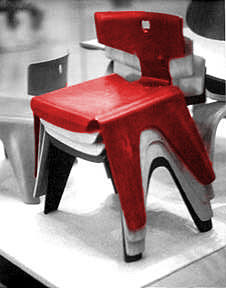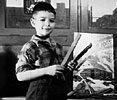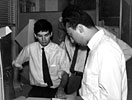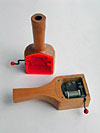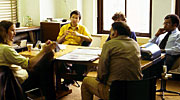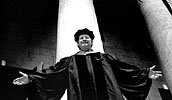Me and design
children's chair by Charles Eames, 1944 |
I grew up in a home where my parents were very aware of design. They were both art teachers in the NYC school system. In the 1930's they had designed and renovated a living space in an old three story storefront building in the east Bronx. They even bought an upright piano which was custom built to their specifications-- no frills, just plain birch veneer, finished clear. It was in this house that I grew up.
By the time I was born the house was filled with furniture they had purchased at the 1939 World's Fair-- chairs by Breuer, Avar Alto, and Jens Risom. One of my earliest seats (when I was 4) was the bright red "children's chair" designed by Charles Eames.
We regularly visited the Museum of Modern Art where, as members, we could go up to the penthouse cafeteria and look out over the city.
At home I grew up looking at, and learning to read from, Norman BelGeddes' book "Horizons," (1932) and his subsequent "Magic Motorways" (1940) as well as a book called "Circle" (a dialog about constructivist art with many pictures) and a 1938 book about the Bauhaus published by MOMA.
My parents had both taken courses with Josef Albers, and when books like Kepes' "Language of Vision" (1944) and Lazlo Moholy-Nagy's "Vision in Motion" (1947) came out, I was reading them, although not quite understanding them!

 I
was always very visual. My first "drawing"
was dated by my father as June 2, 1942. I was 1 year and 2 days old. By
age 5 1/2 (February, 1947) I did my first
pastel rendering of a radio, and by age 8 (July, 1948) I was well
into cross-sectioning of automobiles.
(30 years later, my skill had much improved,
but the ideas remained the same!)
I
was always very visual. My first "drawing"
was dated by my father as June 2, 1942. I was 1 year and 2 days old. By
age 5 1/2 (February, 1947) I did my first
pastel rendering of a radio, and by age 8 (July, 1948) I was well
into cross-sectioning of automobiles.
(30 years later, my skill had much improved,
but the ideas remained the same!)
Age 4. Photo by Alex Fisher. |
|
Done to demonstrate technique of "explosion" plus line/edge variations, 1976. |
Most of all, I was interested in things mechanical. The gears and ratchets I saw on the motors and the rides at the amusement park fascinated me more than the rides themselves. I built linkages with my "Erector Set" ("Meccano" to those from the UK!), and buildings with my "Lincoln Logs" and blocks.
There was never any doubt that what I wanted to be was an industrial designer. Because I was getting all the "art" I needed at home, I never took any art classes in high school, concentrating instead on an academic program. When it came time to select a college, my high school guidance counselor suggested I apply to Swarthmore, Oberlin, and Brown. Pratt Institute in Brooklyn NY had the reputation as having the best industrial design program in the country. To the dismay of my guidance counselor ("Pratt? But that's a trade school!"), I put together a portfolio, and applied. It was the only school to which I applied. I was accepted, and began my courses in the fall of 1959.
Through my four years, I was blessed with some magnificent teachers, although I grew to understand some of them only in retrospect. I had Rowena Reed Kostellow who got me to understand form on a very deep level, Ivan Rigby who exuded good taste, Ron Beckman who pushed a lot of my buttons, Gerald Gulotta and Sam Lebowitz who led me through formal explorations, and Bill Katavalos who taught me (on many levels) how to think.
At my first job at Schwartz/Wassyng Design, NYC. Discussing a job with project director Owen Coleman. |
I graduated in 1963 and proceeded to get a number of jobs in the field: Schwartz/Wassyng, a product and package design office who did work for Seagrams, Clairol, Faberge, and similar clients; Braun Packaging, who had a small design staff connected with their injection molding and stamping facility (clamshell boxes for watches, pens, knives, etc.); and Carl Otto Design, a small office doing work for Seagrams, Royal Typewriters, Yale forklifts.
All the while I was looking around for something else. I knew I was interested in design, but none of the jobs was quite what I wanted. Along the way I had a most disappointing interview with the Raymond Loewy office in New York. They looked at my portfolio, saw bottles and typewriters, and told me they were working on trains and if they ever did typewriters they would give me a call. I was stunned and amazed by their narrowness of vision.
|
Prototype (turned) at rear, final (shaped) at front. |
|
Playtown Garage. Series also had a Fire Station, Marina, and Airport. |
I wound up with a job at Creative Playthings in Princeton, NJ. Creative Playthings was a small company whose business was centered around wooden toys. In 1966 or so they were purchased by CBS, who poured money into the company and established a design office for them. The original owners were nominally in charge.
I designed a hand-cranked music box toy (ripped off by Hong Kong-- a sure sign of success) and a complete re-work of "playtown" items. I was then transferred to another area (The Learning Center) within the design department. In the long run, it was a blessing. We were working on educational science toys and I became interested in education.
One of the lines was a "Discovery of the Month" series, and I did a set that taught principles of musical instruments. Unfortunately, my immediate superior was a non-thinking plodder and an impossible person to get along with. I decided to leave, and was making preparations to do so. One day he said something at which I took offense and I responded with, as the great country and western singer Johnny Paycheck sung, "Take this job and shove it." As I recall, a few more expletives referring to his anal orifice, his male anatomy and his possible sexual relationship to his mother were used. They heard me all the way down in accounting. It felt great! How many wish they could do that and never do?
I found myself at home at 10 o'clock on a Tuesday morning with no job. What to do?
The answer, of course, lay in going deep within and asking. It was 1969. What else to do? That weekend I ingested 500 micrograms of "orange sunshine" and sat in meditation in the local cemetery (the only quiet place in my little town) for the afternoon.
I decided that I knew a lot about many things and it was my mission to teach others what I knew. Education was the answer.
|
End of the year critique, Drew Jones (student), me, Brian Dressler (partially hidden), Noel Mayo (Head of Department), Jack Andrews. |
I phoned the employment service at Pratt, and they said that a graduate of the ID department was running the ID program at the Philadelphia College of Art, and was looking for a teacher. I phoned him, went for an interview, and was hired. As quick as that.
I moved to Philadelphia in August 1969, and left the tenured position in 1995 when I moved to New Zealand. It was a wonderful 26 years.
|
Looking out to the courtyard from the ID Department. 1970. |
I taught all the classes in the ID Department at some time, but settled in teaching Sophomore level drawing (both conceptual and technical) and the major Sophomore design studio. I also taught one section per year in Three-Dimensional Design at the 1st year "Foundation" level.
|
In full robes at my last graduation ceremony, University of the Arts, May, 1995. |
It was the most wonderful job I have ever had. Being able, day in and day out, to work at turning people on to the joys of dimensional design and thinking is a blessing. Having a student experience the big "Ah ha!" is a gift beyond all price.
When I moved to New Zealand I worked for a while as a part-time tutor in the Industrial Design department at the Wellington Polytechnic and, for the last few years, I have been teaching drawing (and thinking) part time at Whitireia Polytechnic -- just a stone's throw from my house.
I think back to the trip in the cemetery in 1969. My major realization was that I would be lucky if, as a designer, I would be able to contribute one valuable thing to the universe. But as an educator, I could teach perhaps 30 people a year. If each of them, because of their education, were able to give one good thing to the universe, then I would have been of more value to the universe as an educator than as a product designer.
At an Industrial Design Society of America meeting many years ago, the
ID faculty of a number of schools were showing the products their students
had designed. Rini Petrini, the chair of an ID department at a school
in Montana, showed a slide of his class of students and said, "These
are my products." Indeed!
